Abstract
Climate change is disrupting marine ecosystems, necessitating a deeper understanding of environmental and fishing-related impacts on exploited species. This study examines the effects of physical factors (temperature, thermal anomalies, salinity, seabed conditions), biogeochemical elements (pH, oxygen levels, nutrients, primary production), and fishing pressure on the biomass of commercially important species in the Alboran Sea from 1999 to 2022. Data were sourced from the Copernicus observational program, focusing on the geographical sub-area 1 (GSA-1) zone across three depth ranges. Generalized Additive Models were applied for analysis. Rising temperatures and seasonal anomalies have largely negative effects, disrupting species’ physiological balance. Changes in water quality, including improved nutrient and oxygen concentrations, have yielded complex ecological responses. Fishing indices highlight the vulnerability of small pelagic fish to climate change and overfishing, underscoring their economic and ecological significance. These findings stress the urgent need for ecosystem-based management strategies that integrate climate change impacts to ensure sustainable marine resource management.
Keywords:
global change; Copernicus; functional groups; overfishing; small pelagic fish; temperature 1. Introduction
For decades, research has examined the long-term effects of inadequate fisheries management [1,2,3] leading to local species extinctions, such as the anchovy in the Alboran Sea [4]. In response, numerous international agreements have been established to improve regulation, most notably the FAO’s Code of Conduct for Responsible Fisheries [5], which recognizes fishing as “a vital source of food, employment, recreation, trade, and economic well-being for people worldwide” that must be preserved for present and future generations. Despite these efforts, global production—both from wild captures and aquaculture—has continued to rise [6]. The Mediterranean, along with the Black Sea, ranks first in unsustainable fishing, with 62.5% of catches exceeding sustainability levels in 2017 [6]. Additionally, unregistered fishing (e.g., discards, illegal fishing, recreational fishing) in the Alboran Sea is nearly twice the reported amount [7].
The Spanish fishing sector has historically been crucial for the regional economy of coastal communities, though its profitability has declined in recent years [1,8]. In the Alboran Sea, artisanal fishing has been an integral part of local culture for generations, with small pelagic species—such as sardines and anchovies—being particularly important [9,10]. Following the 20th century, capture techniques advanced significantly, reducing equipment size and workforce needs, leading to increased production. This growth was further supported by the tourism boom of the 1960s and 1970s, which drove high demand for these species [11]. The FAO [6] highlighted that small pelagic fish, including sardines, anchovies, herring, and mackerel, are among the most exploited globally. In 2018, this group reached a market value of approximately €10.638 billion in the Alboran Sea [12].
Beyond fishing pressures, small pelagic fish are particularly sensitive to environmental fluctuations [13]. These species are primarily plankton feeders [14], and plankton availability is directly influenced by water temperature, being more abundant in colder waters. Consequently, chlorophyll concentration is used as a key indicator of their status [15]. Moreover, they play a crucial role in marine food webs due to their “wasp-waist” structure [16,17], dominating their trophic level and facilitating energy transfer from primary producers to predators [18]. The loss of these species could trigger cascading negative ecological effects.
Several studies [19,20,21,22] emphasize the importance of considering environmental fluctuations when managing this resource. Rising water temperatures, for instance, have been linked to reductions in fish size, reproduction, and survival rates, directly affecting biomass yields [19]. Generalist species have increased their minimum depth in response to warming, potentially restructuring trophic interactions [23] and leading to the disappearance or rarity of cold-water stenothermic species [20]. Climate models predict that the Mediterranean will be one of the most affected regions, experiencing significant warming and more extreme events [24]. Studies by the Spanish Institute of Oceanography indicate that intermediate and deep Mediterranean waters are warming at a rate of 0.2–0.3 °C per century, while surface waters in the Alboran Sea show a trend of 2 °C per century [25].
In addition to temperature, changes in thermohaline circulation, stratification, and salinity have also been observed [20]. Mediterranean research suggests rising temperatures may decrease oxygen levels in the water, negatively impacting large, active fish species, which are also among the most heavily fished [26,27]. Another factor contributing to oxygen depletion is eutrophication, which occurs when water contains high concentrations of nutrients such as phosphates and nitrates [28]. Although these nutrients typically limit phytoplankton growth, excessive concentrations—often caused by wastewater discharges—can result in excessive primary production [29].
These fluctuations in temperature and biogeochemical conditions, combined with increasing fishing pressures, are expected to impact the Alboran Sea species in different ways. This study aims to determine the influence of physical factors (potential water temperature, seasonal thermal anomalies, seabed temperature, euphotic zone depth, salinity), biogeochemical factors (pH, alkalinity, dissolved oxygen concentration, dissolved inorganic carbon concentration, ammonium, nitrate, phosphate, net primary production, phytoplankton concentration, chlorophyll concentration), and fishing pressure (primary production required to sustain fishing index, secondary production loss index, mean trophic level index) on functional groups of exploited species landed in Andalusian fish markets from 1999 to 2024. Additionally, this study assesses the impact of these factors on key commercial species in the region. It also includes biomass projections under two contrasting climate change scenarios, mitigation and catastrophic, providing insight into future vulnerabilities.
2. Materials and Methods
2.1. Study Area
The Alboran Sea is a sub-basin of the western Mediterranean that extends from the Strait of Gibraltar to Cape Gata, serving as a natural border between Europe and North Africa [30]. It is characterized by the inflow of the Atlantic Current into the Mediterranean, generating large anticyclonic gyres in the upper part of the water column. Below the surface, this Atlantic water progressively sinks and accumulates at intermediate depths. At greater depths, the water is colder and saltier, primarily composed from the deep Mediterranean layers [25]. These conditions create a transition zone that favors the presence of a wide variety of marine species [31].
The climate found in the Mediterranean Sea is defined as subtropical and mid-latitude [32]. Therefore, the climate of the Alboran Sea is characterized by predominantly mild and humid winters (October to April) and hot, very dry summers (June to August) [33]. As is typical of the boarder Mediterranean basin, evaporation exceeds freshwater input thought the year [34], which results in high salinity levels in the water [25].
To carry out a rigorous assessment and monitoring of living marine resources, the Food and Agriculture Organization of the United Nations established the General Fisheries Commission for the Mediterranean (https://www.fao.org/gfcm/data/maps/gsas/en/ (accessed on 1 January 2022)), which divides the Mediterranean Sea and the Black Sea into 30 Geographical Subareas (GSAs). Our study focuses on GSA-1, located in the northern Alboran Sea (24.099 km2), encompassing the Andalusian coastline (Figure 1). Additionally, this study covers depths of up to 701.93 m, divided into depth ranges to account for the varying environmental conditions encountered throughout the water column.
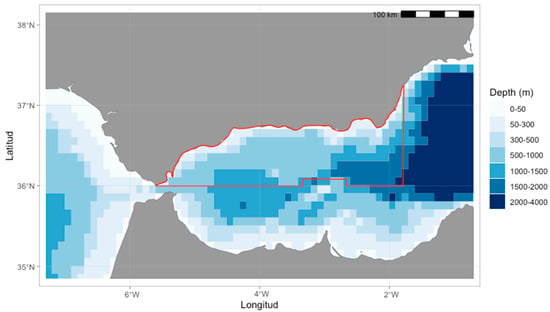
Figure 1.
Bathymetric map of the study area marked in red. Created in R Studio version 4.3.3 (29 February 2024 ucrt) using the “ggOceanMaps” package.
The first range lies within the euphotic zone, which extends approximately to 50 m in depth, and in this study spans from 1 to 42 m (R1). The euphotic zone is the uppermost layer of the ocean that receives sunlight, supporting a high concentration of photosynthetic organisms that form the base of marine food webs [35]. The second depth range, spanning from 51 to 182 m (R2), reflects the transitional layer influenced by the inflow of the Atlantic Current into the Mediterranean. This Atlantic water tends to accumulate at depths approaching 200 m, resulting in temperatures and salinity conditions that differ from those of the underlying Mediterranean waters. The third and deepest range, from 226 to 701 m (R2), corresponds to the denser and saltier Mediterranean water [25].
2.2. Experimental Design
The experimental design for modeling and forecasting fisheries dynamics in the study area involved a structural workflow encompassing data acquisition, environmental and fisheries data integrations and advance statistical analysis, culminating in future scenario projections (Figure 2).
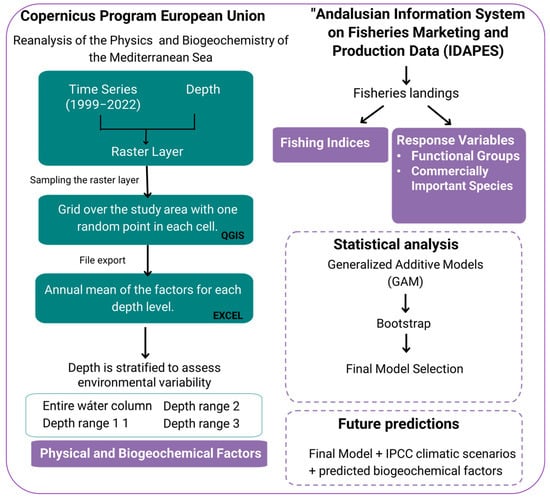
Figure 2.
Workflow and experimental design starting with data acquisition for both fisheries and environmental variables, statistical analysis, and future predictions.
2.2.1. Geospatial Data Extraction and Processing
Amongst the various oceanographic products available in Copernicus’ Marine Environment Monitoring Service (https://data.marine.copernicus.eu/products (accessed on 1 March 2025)), two key datasets were used in this study: Mediterranean Sea Physics Reanalysis and Mediterranean Sea Biogeochemistry Reanalysis. Data were collected for the study period from January 1999 to December 2022, covering a vertical depth range from 1 to 702 m. A temporally dimensioned raster layer was generated for each depth level in NetCDF format (.nc).
To extract and process the explanatory variables, a combination of geospatial and tabular data handling was carried out using R. The workflow relied on several packages, including terra, sf, dplyr, lubridate, stringr, tibble, and readxl.
First, a grid composed of approximately 19,000 cells (each covering 1.21 km2) was created over the study area. Within each cell, a random point was selected. The resulting shapfile of sampling points was then converted into a SpatVector object using the terra package to enable compatibility with raster operations.
Each environmental factor was then batch-processed through a four loop. Raster files were loaded into R as SpatRaster objects. The temporal metadata embedded in each NetCDF file were extracted and converted into a proper date–time format, which was then used to label each raster layer according to its corresponding year.
For each raster file, the environmental values were extracted through our sampling points using the extract () function. The extracted data were then averaged across all points to obtain a single mean value per timestamp. This process was repeated for each raster file, and the results were compiled into a single data frame, where each row represented each raster file (depth layer), and each column corresponds to the average for each year.
Additional averages were then computed for the entire depth range (TOT) as well as for the predefined depth zones: R1, R2, and R3. In the case of potential temperature, monthly means at 1.02 m depth were also calculated for the period 1987–2022 to estimate sea surface temperature anomalies following the methodology proposed by Iglesias et al. [36]. These anomalies were computed seasonally: winter (December, January, and February), spring (March, April, and May), summer (June, July, and August), and autumn (September, October, and November). Seasonal superficial temperature anomalies, derived from the monthly means at 1 m, were used for TOT and R1. In contrast, seasonal thermal anomalies specific to each depth were calculated for R2 and R3. A detailed list of all environmental and biogeochemical variables can be found in Table S1 in the Supplementary Material.
2.2.2. Fisheries in Andalusia
Landings data for each commercially harvested species within GSA-01 from 1999 to 2022 were obtained from IDAPES, the Andalusian Information System for Fishery Production and Commercialization Data (https://www.juntadeandalucia.es/agriculturaypesca/idapes/servlet/FrontController?ec=observatorio (accessed on 1 March 2025)). For further analysis, each species was assigned to a trophic level and an estimate of its trophic transfer efficiency to the next level, based on values from Coll et al. [37].
Following a literature review, species were classified into functional groups based on criteria such as feeding behavior and habitat similarity. For this study, five groups were selected: benthic cephalopods (7 species), benthic mollusks excluding cephalopods (45 species), decapods (35 species), small pelagic fish (32 species), and large pelagic fish (28 species). The detailed species composition for each group can be found in the Supplementary Material (Table S2). Each species was assigned to one or more depth range, depending on the zone in which they typically reside [38,39,40,41,42,43,44]. This study focuses on the above cited due to their ecological relevance and importance in fisheries.
The most commercially important species in the Alboran Sea, according to several sources [9,45], were also considered separately and are listed in Table 1, along with their corresponding depth ranges.

Table 1.
List of the most commercially important species in the Alboran Sea and their assigned depth range(s).
To include fishing pressure on these populations, three indexes were considered and used as explanatory variables in the statistical analysis: the Primary Production Required (PPR), the Loss in Secondary Production (L), and the Mean Trophic Level (MTL) of catches.
Following previous studies conducted in the Mediterranean Sea, a trophic transfer efficiency (TE) value of 0.14 was used [46]. Species-specific trophic level values (TLi) were obtained from numerous sources and are provided in Table S2 of the Supplementary Material.
The first index is PPR as proposed by Pauly & Christensen [1]. Using the annual landings of each species from the previous year (Yi), their respective trophic levels (TLi), and the trophic transfer efficiencies (TE), according to the following formula:
PPR = 1/9 Σ [Yi × (1/TE)TLi−1].
The second index is L, which is applied to assess overfishing in ecosystems managed by industrial fisheries [39]. The index considers primary production (P), as the capture of species across different trophic levels result in a progressive loss of production:
L = −1/P1 × lnTE Σ (PPRi × TETLi−1)
Lastly, the MTL was used to monitor biodiversity loss in marine ecosystems [47]. This index combines the TLi with total catches (Ytot) to reflect changes occurring within the ecosystem and is widely applied in fisheries science and management [48]:
MTI = Σ (TLi × Yi)/Ytot
2.3. Statistical Analysis
All throughout the statistical analysis, R version 4.3.3 (29 February 2024 ucrt) was used. A normality check was performed for the response variables, in other words, the functional groups and the most commercially relevant species. For this purpose, the Shapiro–Wilk test was applied, using a significance level of p < 0.05. In cases where the data did not follow a normal distribution, data transformations were applied to improve normality depending on the distributional characteristics of each variable:
- -
- Logarithm transformation: blue and red shrimp, horse mackerel, large pelagic fish, mackerel, Norway lobster and small pelagic fish.
- -
- Square root transformation: anchovies and deepwater rose shrimp.
Inverse transformation: decapods and hake
Since the use of highly correlated explanatory variables in a statistical model can lead to biased results, a Pearson correlation matrix was computed. According to previous studies, variables with correlation coefficients below 0.6 were considered suitable for inclusion [49]. Based on this criteria, different combinations of factors were created for subsequent incorporation into the model. To automate this selection, a custom R function was developed. This function iteratively tests all possible combinations of the selected variables, filtering out those in which any pair of variables exceeds the predefined correlation threshold.
The algorithm works by generating combinations of decreasing size (from the total number of variables down to pairs), and for each combination, it evaluated the maximum pairwise correlation. Only those where all correlations remain below the threshold are retained. The function ensures that the largest possible sets of uncorrelated variables are selected for model input. This approach minimizes multicollinearity and ensures model robustness.
To assess the relationship between the explanatory factors to the response variable, Generalized Additive Models (GAMs) were used. Unlike traditional Generalized Linear Models (GLMs), GAMs allow for the detection of non-linear and curvilinear patterns in the predictors [50]. To determine which explanatory variables required smoothing, a comparative analysis was performed using GAMs with and without smoothing terms. For each variable, two models were fitted: a linear GAM and a smoothed one, both using the Restricted Maximum Likelihood (REML) estimation method.
The performance of both models was evaluated using the Akaike Information Criterion (AIC). If the smoothed version produced a lower AIC value than the linear one, the variable was considered to benefit from the inclusion of a smoothing term. This approach allowed for an objective and reproducible selection of variables that exhibited non-linear temporal patterns, thereby justifying the use of cubic regression spline with a knot value (k) below 5 to avoid overfitting.
To identify the most robust models for each species, a stepwise backward selection approach was implemented within the GAM framework. The selection process began with a full GAM containing all uncorrelated explanatory variables, where smoothing functions were applied selectively. A function was developed to iteratively eliminate terms that did not contribute significantly to model performance. At each step, the function evaluated all possible reduced models by removing one term at a time. The best model was retained only if it produced a lower AIC value, provided that the drop in explained variable (R2) did not exceed the threshold (R2 ≤ 0.02), thus preventing significant loss of model performance.
This stepwise method was applied across all the dependent variables. For each one, the data were filtered, and a set of GAMs was fitted using the pre-validated combinations of explanatory variables. Each model was dynamically constructed by applying smoothing functions only those variables that had previously shown improved performance under non-linear transformations.
Final models were stored and labeled systematically, allowing for later inspection, visualization and comparison. Additionally, each model was evaluated using the gam.check() function from the mgcv package to verify the adequacy of residual patterns and smoothness selection. To assess model stability and the variability of performance metrics, a nonparametric bootstrap with replacement was applied, fitting each model to 1000 resampled datasets. This case-resampling bootstrap was used to estimate 95% confidence intervals for R2, providing insight into the robustness of each model. Although there is no strict threshold, wide intervals may suggest potential instability, especially in small samples.
2.4. Climate Change Scenarios and Projections
The relationship between fishery biomass and seasonal sea temperature anomalies, as well as sea floor temperature, and the other biogeochemical variables, was used to project potential responses under future climate change scenarios. Following the latest IPBES report [51], two contrasting thermal scenarios were defined for projections extending to the year 2100: a mitigation scenario, characterized by a +2 °C increase, and a catastrophic scenario, with +3.5 °C increase.
All thermal parameters applied in the simulation were based on projections presented by Soto-Navarro et al. [52], which closely approximate the conditions of the defined thermal scenarios. Specifically, under the Representative Concentration Pathway (RCP) 4.5 scenario, with a reported sea surface and intermediate water temperature increase of +1.3 °C and +1.15 °C, respectively. Under the RCP8.5 scenario, these increases reached +2.42 °C at the surface and +2.24 °C in intermediate waters. For sea floor temperature, anomalies at deepwater levels were used, with a +0.16 °C for the mitigation scenario and +0.21 °C for the catastrophic scenario.
Finally, projections from Reale et al. [53] were used for salinity, phosphate and nitrate concentrations, dissolved oxygen, dissolved inorganic carbon, phytoplankton, primary production, and pH. These combined parameters were used to predict the expected fishery biomass under each climate scenario using the fitted GAMs.
3. Results
3.1. Modelling
Significant variables, depth ranges, R2 coefficients, and confidence intervals for each final model selected for the commercial groups and the species of highest commercial interest within the study area are presented in Table 2. These models correspond to the depth range that most accurately represents the response variable after computing the Akaike Information Criterion (AIC). The full model formula, as it appears in the R output, is available in Table S3 of the Supplementary Material.

3.1.1. Functional Groups
- Benthic cephalopods
The final GAM selected, based on the lowest AIC value, corresponds to the total water column range and exhibited a high explanatory power (R2 = 0.77). Significant parametric effects were observed for winter anomalies (p = 0.006) showing a strong negative influence on the landings’ biomass. Smooth terms revealed a highly significant nonlinear effect of FLOOR_TEMP (p < 0.001) and a significant effect of SAL (p < 0.001). As illustrated in Figure 3, the floor temperature showed a decreasing effect on the biomass before stabilizing between 13.30 °C and 13.4 °C, followed by a further decline. In contrast, biomass tended to increase at intermediate salinity levels.
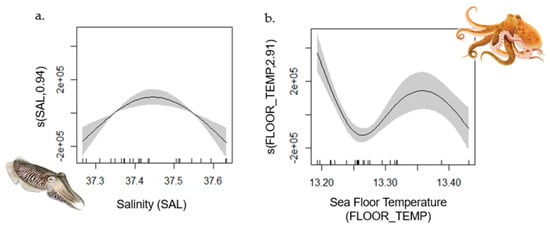
Figure 3.
GAM plots showing partial effects of selected explanatory variables on the landings’ biomass of benthic cephalopods: (a) Salinity and (b) Sea floor temperature. The y axis represents the partial effect of the variable, the tick marks on the x axis represent observed data. The shaded area shows the 95% confidence interval. Created in R Studio version 4.3.3 (29 February 2024 ucrt).
- Benthic Mollusks
The GAM selected explained 71.5% of the deviance, with an adjusted R2 of 0.655. ANOM_SPR_2, O2_2 and MTI had very significant negative effects (p < 0.01).
- Decapods
Decapods’ selected model also belongs to the total water column range. The model explained 98,9% of the deviance, with an adjusted R2 of 0.74. Among parametric terms, L index, MTI, floor temperature and pH had very significant (p < 0.001) negative effects on the landings, while SAL (p < 0.001), ANOM_T_AUT (p = 0.009) and ANOM_T_SPR (p = 0.019) were positively associated.
As Illustrated in Figure 4 the smooth term revealed a peak of biomass at around 0.26 mmol/m3 of NH4 (p < 0.001), before rapidly decreasing as its concentration increased.
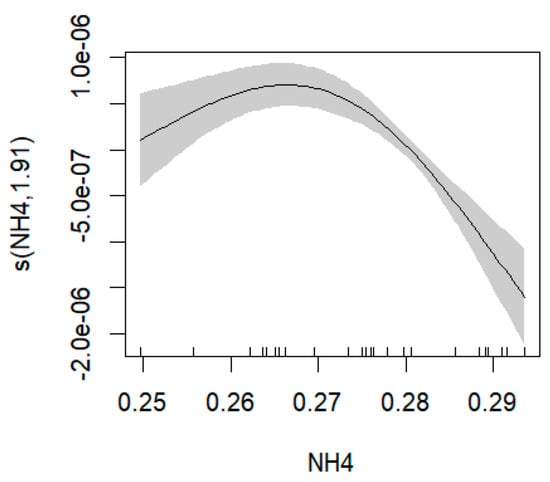
Figure 4.
GAM plots showing partial effects of Ammonia concentration on the landings’ biomass of Decapods. The y axis represents the partial effect of the variable, the tick marks on the x axis represent observed data. The shaded area shows the 95% confidence interval. Created in R Studio version 4.3.3 (29 February 2024 ucrt).
- Large Pelagic Fish
The final GAM selected for this functional group explained a very high proportion of the variability in the data, with an adjusted R2 of 0.817 and 94.2% deviance explained. Among the parametric terms, MTI index (p = 0.007) had a strong positive effect, while SAL (p = 0.023) and NO3 (p = 0.002) showed significative negative associations with biomass. Superficial temperature anomalies during summer (p = 0.039) and autumn (p = 0.006) also presented strong negative effects.
All smooth terms exhibited significant nonlinear effects, with NH4 having a particularly strong association with the caught biomass of large pelagic fish species (p < 0.001). As illustrated in Figure 5, biomass levels had strong fluctuations in relation to ammonium concentration, with notable peaks around 0.26 mmol/m3 and again from 0.28 mmol/m3 onwards. ANOM_T_SPR (p = 0.001) had a very sharp decline in biomass under warmer anomalies. Although phytoplankton concentration was significant (p = 0.006), its effect appeared weaker and predominantly negative. Lastly, pH (p = 0.004) had a negative effect on landing biomass as pH increased.
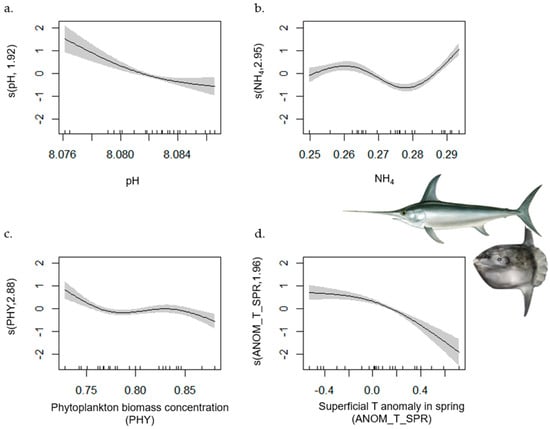
Figure 5.
GAM plots showing partial effects of selected explanatory variables on the landings’ biomass of Large pelagic fish: (a) pH; (b) Ammonium concentration; (c) Phytoplankton biomass concentration, and (d) Superficial temperature anomaly in spring. The y axis represents the partial effect of the variable, the tick marks on the x axis represent observed data. The shaded area shows the 95% confidence interval. Created in R Studio version 4.3.3 (29 February 2024 ucrt).
- Small Pelagic Fish
The model selected for small pelagic fish explained 88.6% of the deviance, with an adjusted R2 of 0.75, indicating a good explanatory power. Among parametric terms, NH4_1, ANOM_T_WIN and ANOM_T_SUM had very significant negative effects on biomass (p < 0.001).
Regarding the smooth terms, FLOOR_TEMP (p = 0.009) showed a sharp decrease in biomass at lower temperatures (13.2–13.25 °C), followed by a mild increase toward 13.3 °C before dropping once more, indicating a narrow optimum thermal range. As can be seen in Figure 6, another very significant term was the superficial temperature anomaly in autumn (p = 0.001), with landings’ biomass increasing under moderate cooler anomalies, peaking around −0.2 to 0 °C, and declining as anomalies become warmer.
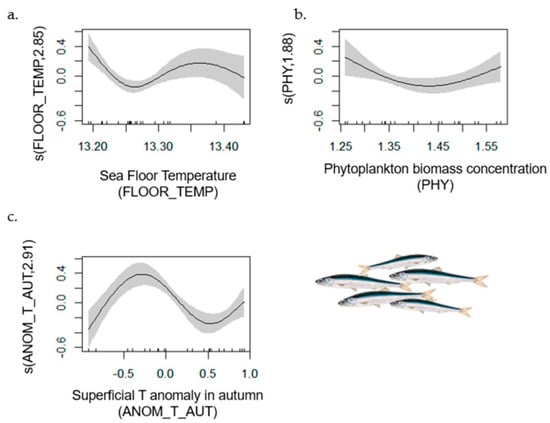
Figure 6.
GAM plots showing partial effects of selected explanatory variables on the landings’ biomass of Small pelagic fish: (a) Sea floor temperature; (b) Phytoplankton biomass concentration, and (c) Superficial temperature anomaly in autumn. The y axis represents the partial effect of the variable, the tick marks on the x axis represent observed data. The shaded area shows the 95% confidence interval. Created in R Studio version 4.3.3 (29 February 2024 ucrt).
3.1.2. Commercially Important Species and Groups
- Atlantic bonito
In this first species, the selected GAM explained 95.4% of deviance, with an adjusted R2 of 0.90, slightly below the upper limit of the CI 95% calculated with the bootstrap (Table 2). Almost all parametric terms were significant, CHL (p = 0.03) showed a positive association with biomass, while FLOOR_TEMP, NO3 and ANOMT_T_SPR showed a strong negative effect (p < 0.001).
Smooth terms graphs are presented in Figure 7; pH (p < 0.001) showed a clear negative effect on biomass. SAL (p = 0.003) displayed a weak U-shaped curve, with higher biomass at both low and high salinity levels. Lastly, NH4 also had a U-shaped curve, but with a sharp decrease in biomass up to 0.28 mmol/m3.
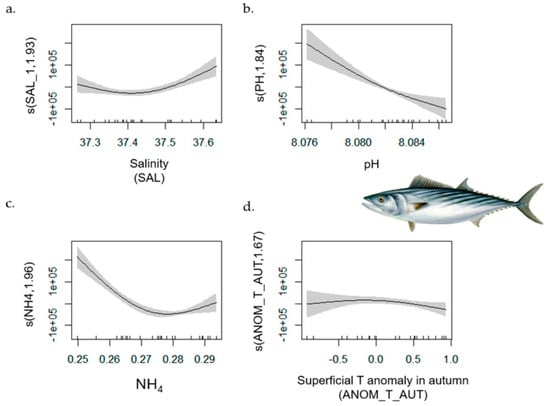
Figure 7.
GAM plots showing partial effects of selected explanatory variables on the landings’ biomass of Atlantic bonito: (a) Salinity; (b) pH; (c) Ammonium concentration, and (d) Superficial temperature anomaly in autumn. The y axis represents the partial effect of the variable, the tick marks on the x axis represent observed data. The shaded area shows the 95% confidence interval. Created in R Studio version 4.3.3 (29 February 2024 ucrt).
- Anchovy
The model developed for anchovy explained 93.8% of the deviance, with an adjusted R2 of 0.861. Among the parametric terms, L index had a highly significant negative effect on biomass (p < 0.001), while ANOM_T_SUM, SAL_1 and ANOM_T_SPR showed less strong negative impact (p < 0.05). All smooth terms had significant non-linear responses (Figure 8). FLOOR_TEMP (p < 0.001) had a positive effect on biomass, while ANOM_T_AUT (p < 0.001) showed a steep negative effect up approximately −0.2 °C, followed by a slight increase and a final decrease, indicating that moderate warm anomalies could be favorable to biomass. NH4_1 (p < 0.001) has a U-shaped association with a rapid increase starting from 0.275 mmol/m3. Lastly, PHY_1 (p < 0.001) displayed the opposite to the previous variable, peaking around 1.4 mmol/m3 and declining at both lower and higher concentrations, suggesting an optimal productivity threshold.
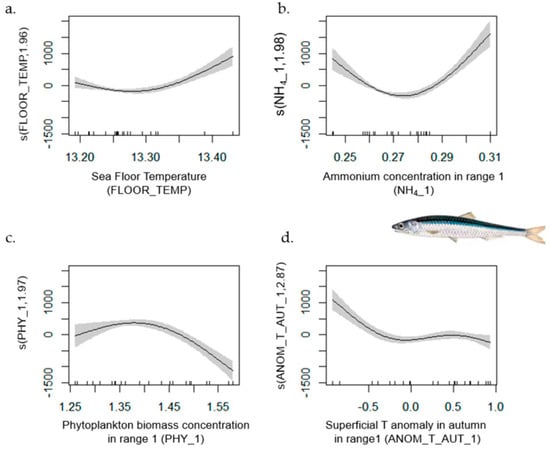
Figure 8.
GAM plots showing partial effects of selected explanatory variables on the landings’ biomass of Anchovies: (a) Sea floor temperature; (b) Ammonium concentration in range 1; (c) Phytoplankton biomass concentration, and (d) Superficial temperature anomaly in autumn. The y axis represents the partial effect of the variable, the tick marks on the x axis represent observed data. The shaded area shows the 95% confidence interval. Created in R Studio version 4.3.3 (29 February 2024 ucrt).
- Blue and red Shrimp
The model developed for Blue and Red Shrimp explained 81.3% of the deviance, with an adjusted R2 of 0.714. Among the parametric terms, MTI, FLOOR_TEMP and NH4 had a significantly positive effect on biomass (p < 0.05), while SAL, ANOM_T_SPR and ANOM_T_AUT had a negative significant association (p < 0.05). As for the smooth term O2, it had a very significantly high non-linear effect (p < 0.001) as shown in Figure 9. The biomass was negatively affected around 225 mol/m3.
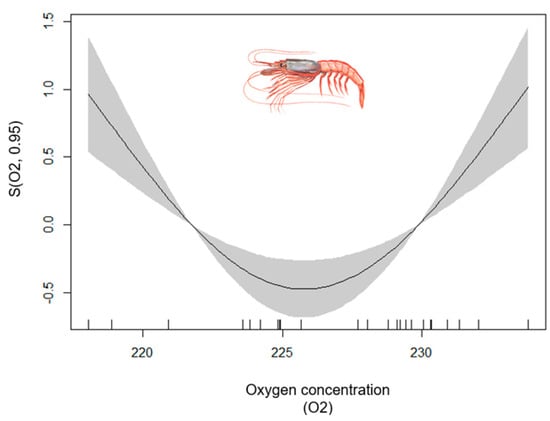
Figure 9.
GAM plots showing partial effects of Oxygen concentration on the landings’ biomass of Blue and red Shrimp. The y axis represents the partial effect of the variable, the tick marks on the x axis represent observed data. The shaded area shows the 95% confidence interval. Created in R Studio version 4.3.3 (29 February 2024 ucrt).
- Sardine
The selected GAM for sardines explained 86.3% of the deviance, with an adjusted R2 of 0.803. All linear predictors had a significant effect on biomass. PPR (p = 0.003), CHL (p = 0.037), pH (p = 0.012), ANOM_T_SPR (p = 0.008) and ANOM_AUT (p = 0.016) were positively associated, whereas ANOM_T_WIN and CAR had a strong negative effect (p < 0.001).
- Mackerel
The model had an adjusted R2 of 0.78, slightly below the CI 95% calculated with the bootstrap. ANOM_T_WIN (p = 0.022), ANOM_T_SUM (p = 0.006) and L_index (p = 0.033) all showed a significant negative relationship with mackerel biomass.
Regarding smooth terms, in Figure 10 it is shown how the biomass decreased once the concentration of ammonium (p < 0.001) surpassed 0.26 mmol/m3. As for ANOM_T_AUT (p = 0.002), the biomass seemed to benefit from slightly cooler anomalies, decreasing with very cold or mildly warm anomalies. Lastly, ANOM_T_SPR (p = 0.048) showed an increase of biomass at around +0.2 °C.
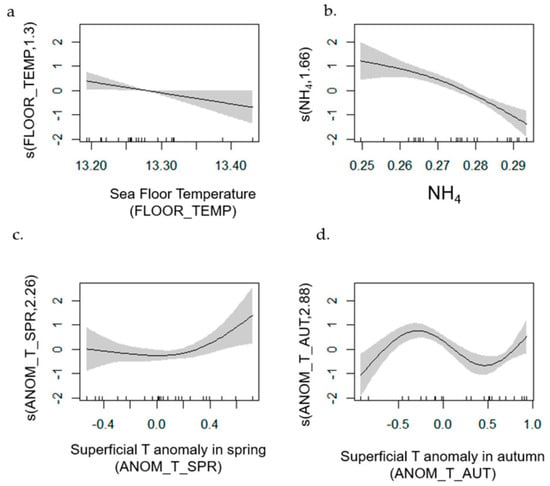
Figure 10.
GAM plots showing partial effects of selected explanatory variables on the landings’ biomass of Mackerel: (a) Sea floor temperature; (b) Ammonium concentration; (c) Superficial temperature anomaly in spring, and (d) Superficial temperature anomaly in autumn. The y axis represents the partial effect of the variable, the tick marks on the x axis represent observed data. The shaded area shows the 95% confidence interval. Created in R Studio version 4.3.3 (29 February 2024 ucrt).
- Red Mullet
The model selected explained a high proportion of the variability, with an adjusted R2 of 0.73 and 83% of deviance explained. Among the linear predictors, both MTI (p = 0.022) and NH4_1 (p = 0.011) showed positive associations with red mullet’s biomass. On the other hand, O2_1 showed a significant negative effect (p = 0.026).
Graphs for the smooth terms are presented in Figure 11, and all the predictors had significant non-linear effects on biomass. The sea floor temperature (p = 0.046) showed a positive relationship up to 13.30 °C and then decreased as temperatures went up. PP_1 (p = 0.005) had a positive effect on biomass around 9.5 mol/m3·day and then decreasing rapidly and then increasing.
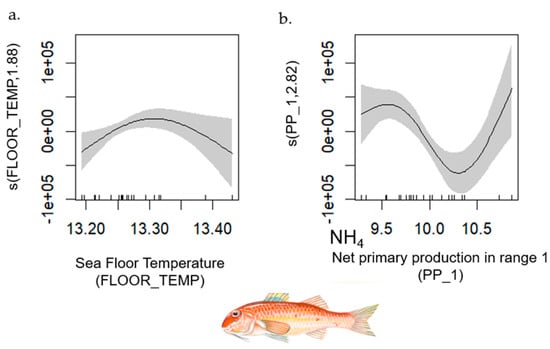
Figure 11.
GAM plots showing partial effects of selected explanatory variables on the landings’ biomass of Red mullet: (a) Sea floor temperature and (b) Net Primary Production in range 1. The y axis represents the partial effect of the variable, the tick marks on the x axis represent observed data. The shaded area shows the 95% confidence interval. Created in R Studio version 4.3.3 (29 February 2024 ucrt).
- Common Octopus
The selected GAM for common octopus explained 73.9% of the deviance, with an adjusted R2 of 0.654. The only parametric term, MTI (p = 0.014) had a positive significant effect on biomass. While both smooth terms had significant non-linear responses (Figure 12). FLOOR_TEMP (p = 0.006) had a negative effect on biomass, while salinity (p = 0.0475) showed an increase in biomass towards 37.7 PSU, until reaching a threshold.
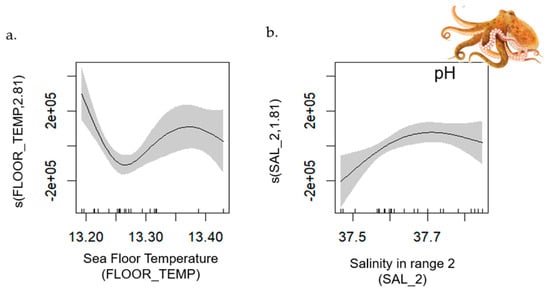
Figure 12.
GAM plots showing partial effects of selected explanatory variables on the landings’ biomass of Common octopus: (a) Sea floor temperature and (b) Salinity in range 2. The y axis represents the partial effect of the variable, the tick marks on the x axis represent observed data. The shaded area shows the 95% confidence interval. Created in R Studio version 4.3.3 (29 February 2024 ucrt).
- Hake
The GAM selected for hake had an adjusted R2 of 0.747 and explained 86.1% of the deviance. Almost all linear and non-linear predictors significantly influenced hake’s landing biomass. Among parametric terms, MTI (p < 0.001) had strong negative effects, while ANOM_T_SUM (p = 0.047) and ANOM_T_AUT (p = 0.006) had significant positive effects.
Model plots for the smooth terms are presented in Figure 13, NH4 (p = 0.002) showed decreasing effect at higher values. Primary production (p < 0.001) and the superficial temperature anomaly in spring (p = 0.007) showed a positive non-linear relationship with landed hake biomass.
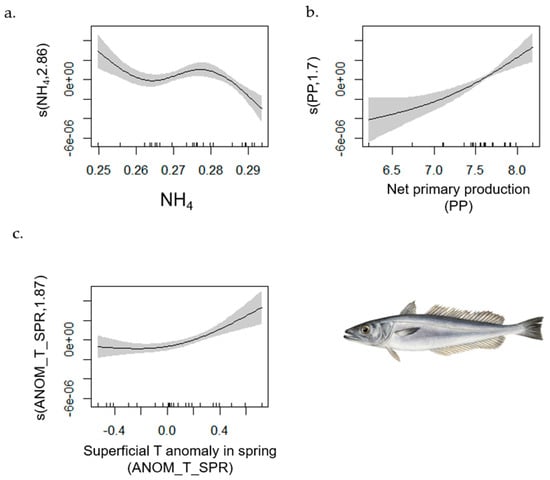
Figure 13.
GAM plots showing partial effects of selected explanatory variables on the landings’ biomass of Hake: (a) Ammonium concentration; (b) Net Primary Production, and (c) Superficial temperature anomaly in spring. The y axis represents the partial effect of the variable, the tick marks on the x axis represent observed data. The shaded area shows the 95% confidence interval. Created in R Studio version 4.3.3 (29 February 2024 ucrt).
- Horse Mackerel
The model explained 72.8% of the deviance and an adjusted R2 of 0.611. Among the linear predictors, L index and PHY had a significantly positive effect on biomass (p = 0.01), while SAL had a much stronger positive association (p < 0.001).
Figure 14 shows the only non-linear predictor, PH (p = 0.001), exhibited a notable increase of biomass up to around 8.08.
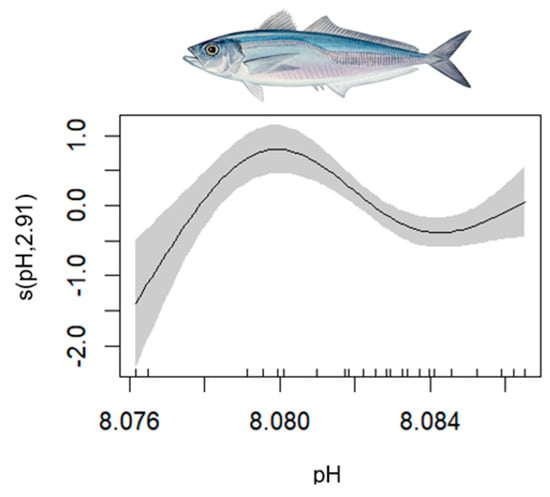
Figure 14.
GAM plot showing partial effects of pH on the landings’ biomass of Horse mackerel. The y axis represents the partial effect of the variable, the tick marks on the x axis represent observed data. The shaded area shows the 95% confidence interval. Created in R Studio version 4.3.3 (29 February 2024 ucrt).
- Deepwater Rose Shrimp
The model selected for deep-water rose shrimp explained 84.3% of the deviance, with an adjusted R2 of 0.78. Among the linear terms, index L (p < 0.001) and CAR_2 (p = 0.006) had a negative effect on the landings. As of smooth terms, only TEMP_POT_2 showed a significant (p < 0.001) U-shaped relationship (Figure 15). The response decreased up to around 14 °C, then increased sharply.
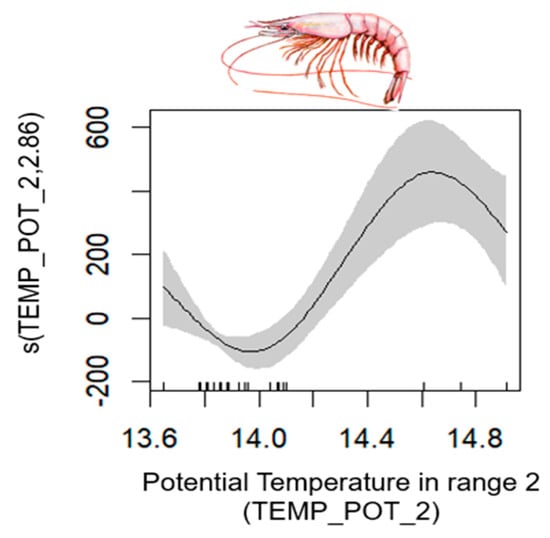
Figure 15.
GAM plots showing partial effects of selected explanatory variables on the landings’ biomass of Deepwater Rose Shrimp: Potential Temperature in range 2. The y axis represents the partial effect of the variable, the tick marks on the x axis represent observed data. The shaded area shows the 95% confidence interval. Created in R Studio version 4.3.3 (29 February 2024 ucrt).
- Norway Lobster
The GAM selected explained a high proportion of the variability in Norway lobster (R2 = 0.80; deviance explained = 87.6%). For the linear terms, biomass had a significant positive association with index L and NH4 (p < 0.05), while SAL (p < 0.001), PHY (p < 0.001), ANOM_T_WIN (p < 0.001) and ANOM_T_AUT (p = 0.025) had significant negative effects. Regarding the non-linear terms, as shown in Figure 16, landings had a clear decrease with warm anomalies during spring (p = 0.0367).
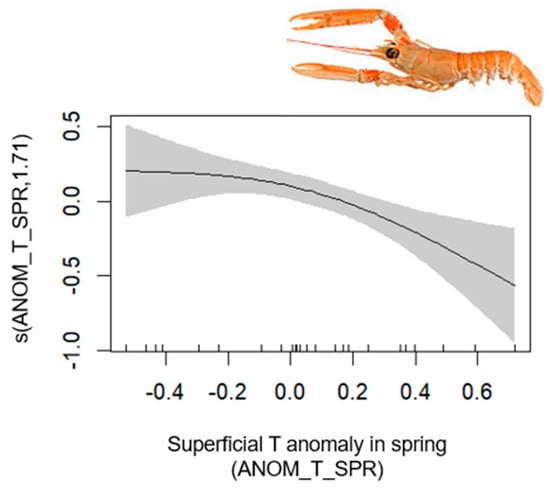
Figure 16.
GAM plot showing partial effects of selected explanatory variable on the landings’ biomass of Norway Lobster: Anomaly in the spring temperature. The y axis represents the partial effect of the variable, the tick marks on the x axis represent observed data. The shaded area shows the 95% confidence interval. Created in R Studio version 4.3.3 (29 February 2024 ucrt).
3.2. Predictive Models with Climate Change Scenarios
During the study period, a clear warming trend was observed in FLOOR_TEMP, with sea floor temperatures steadily increasing over time. In contrast, seasonal anomalies showed more interannual variabilities but with warmer anomalies in the last couple of years. Figure 17 shows the temporal evolution of the sea floor temperature and anomalies for the complete data series.
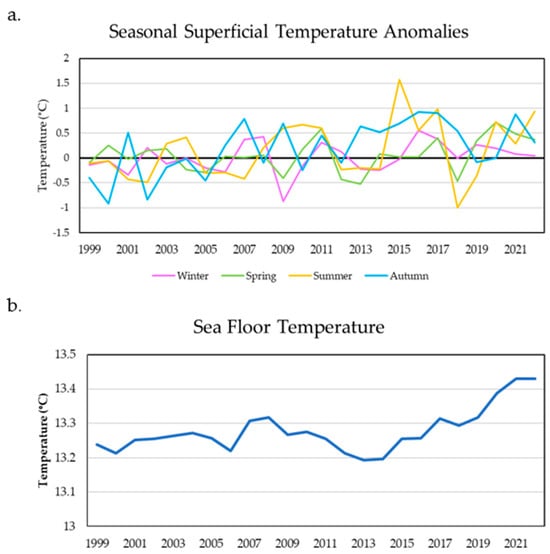
Figure 17.
Temporal evolution of (a) seasonal superficial temperature anomalies and (b) sea floor temperature in the Alboran Sea.
The projected anomalies under both scenarios, mitigation and catastrophic, present substantial differences from historical averages (Table 3), especially in winter and summer. While the floor temperature already showed a notable historical rise that is expected to increase even more by the end of the century.

Table 3.
Projected seasonal superficial temperature anomalies and sea floor temperature under the mitigation and catastrophic scenarios by the year 2100 in the Alboran Sea. Values are in °C.
Not all species were included in the predictive analysis, based on the results obtained in the bootstrap assessment. Models whose 95% confidence interval upper bounds included 1.00 were excluded, as this may indicate potential overfitting. These excluded species included Atlantic bonito, anchovies, small pelagic fish, mackerels, and large pelagic fish. In addition, horse mackerel was also excluded due to its broad CI 95% results (0.36–0.93), which suggested instability in model performance.
As shown in Table 4, there was a decrease in biomass throughout almost all species to varying degrees under both climate scenarios. The most affected commercially important species were deepwater rose shrimp, Norway lobster, and sardine. As for functional groups, benthic cephalopods and benthic mollusks were also severely impacted.

Table 4.
Projected catches for the different species and functional groups in Mitigation and Catastrophic scenarios.
The rest showed less severe decline, including common octopus, hake, and decapods, which experienced reductions in biomass but without completely disappearing. The only species that seemed to not decrease substantially were blue and red shrimp and red mullet.
4. Discussion
4.1. Fishing Impact
In recent years, there has been growing evidence of the impacts of fishing on trophic networks and marine ecosystems [54]. As a result, various indicators have been developed to assess the degree of overexploitation in marine environments. Among these, the MTL index, calculated in the present study, was 3.4, which corresponds to the trophic level of small pelagic fish. However, it is important to note that experts have cautioned against relying solely on this index for assessing fishing pressure, as it can underestimate the impact on areas with high productivity [55,56]. It is for this reason that it is advised to use this index alongside index PPR [57,58].
The PPR index revealed that sardines require for high levels of primary production to sustain current fishing landings. This is expected given its status as one of the most heavily fished species in the Alboran Sea.
High values of L indicate a greater disruption of the food web. In the present study, elevated L values were negatively associated with deepwater rose shrimp, anchovy, horse mackerel, decapods, and benthic mollusks. This is particularly notable given that MTL is 3.4 and these species occupy relatively low trophic levels. Such associations may reflect from broader alterations in ecosystem structure and function, caused by fishing pressures, leading to reduced resilience and changes in species composition [58].
4.2. Environmental Impacts
Several studies have demonstrated that the surface temperature of the Mediterranean Sea has been increasing rapidly in recent decades, and this trend is expected to continue in the future [20,25]. The temperature-related data collected in this study support this pattern. Over the past 20 years, the potential temperature of the water has shown a consistent upward trend, both throughout the entire water column and within specific depth ranges. In terms of surface thermal anomalies, a clear increase in warm anomalies was observed across all seasons in the last couple of years of the study period. Of particular interest is the winter thermal anomaly, which was associated with biomass loss in all models where it was identified as a significant variable.
Regarding the most important functional group—both economically [9] and ecologically [17]—the results showed that the biomass of small pelagic fish was negatively affected by warm anomalies, particularly in winter and summer. In our study, anchovies showed clear negative associations with warm anomalies during summer, spring, and autumn, suggesting their sensitivity to rising temperatures during key periods of their life cycle. Numerous studies [59] have documented this link between sea surface temperature and the abundance of small pelagic species. For instance, Giraldez & Abad [60] found a strong correlation between gonadosomatic index and the temperature in the months preceding the reproductive period that goes from early spring to early autumn with a peak in June-July. Moreover, these species are generally considered planktivorous, meaning that rising temperatures can reduce the availability of their primary food source [14,15]. During 2000–2001, a decrease in average temperature was recorded in the Alboran Sea, which resulted in areas of high chlorophyll concentration-indicative of high primary production. In these areas, many anchovy larvae were detected [61].
Similarly, sardines exhibited a nuanced response to thermal anomalies. Studies on reproductive ecology and larval dynamics in the Alboran Sea suggest that sardine biomass may benefit from warm anomalies to a certain degree in spring and autumn, but not necessarily in winter, as supported by our findings. Warmer spring temperatures have been associated with earlier reproductive readiness [61], as well as enhanced larval growth and survival [62]. These conditions could increase recruitment success and support higher biomass. However, warm anomalies during winter may not provide similar benefits, because of possible phenological mismatch between spawning and planktonic availability [63]. This potential mismatch could decrease larval survival rates and reduce recruitment, ultimately leading to lower biomass.
The sea floor temperature data collected for this study revealed a clear increase in the last decades. This trend had already been reported by the Spanish Institute of Oceanography [25], which emphasized that although +0.3 °C may seem minor, warming such large volumes of water requires a significant amount of energy. A functional group directly affected by this rise are benthic cephalopods and particularly, the common octopus. In our results, their biomass was negatively impacted by both increasing sea floor temperatures and warm thermal anomalies, indicating their vulnerability to ongoing warming in deeper marine layers. Previous studies have shown that elevated temperatures can negatively affect cephalopods, which are ectothermic organisms, particularly during their early life stages. This thermal sensitivity may lead to reduced recruitment success [63,64,65,66,67].
Phytoplankton depends on sunlight and atmospheric carbon dioxide, which is why it is restricted to the upper layer of the ocean, known as the euphotic zone. Carbon dioxide is generally not a limiting factor, as the ocean is its largest reservoir. In contrast, a potential limitation for primary production is the availability of dissolved inorganic nutrients, such as phosphates and nitrates [26,68]. However, excessively high concentrations of these nutrients can lead to an overproduction, resulting in a decrease of dissolved oxygen, which can cause anoxic conditions and the subsequent death of other marine organisms that rely on oxygen [29]. Fortunately, this does not appear to be the case in the Alboran Sea, as oxygen concentration levels registered in the study period remained within healthy ranges.
Nevertheless, several models identified ammonium as a highly significant factor with a negative influence on landed biomass (small pelagic fish, decapods, Atlantic bonito, hake, and mackerel). Ammonium is a compound synthesized though the fixation of atmospheric nitrogen by primary production. It serves as the initial substrate in the nitrification process, which ultimately lead to the formation of nitrate [28]. Interestingly, benthic cephalopods were negatively affected by nitrate concentrations in our results. A study done by newly hatched common octopus paralarvae observed that increased exposure to ammonium and nitrate affected not only their chromatophore activity, but also their feeding [69].
4.3. Prediction Models
Understanding how climate change will impact marine ecosystems is crucial for sustainable fisheries management. The Alboran Sea, a biologically rich transition zone between the Mediterranean and Atlantic waters, is particularly vulnerable to environmental fluctuations [31,70]. Exploring climate change scenarios allows researchers and managers to anticipate potential shifts in species distribution, biomass, and trophic dynamics, offering vital insights into the resilience of marine resources [71,72,73]. As expected, in the catastrophic scenario (+3.5 °C), almost all species included in the model disappeared from fisheries landings, effectively collapsing the entire industry. The only exceptions being red mullet and blue and red shrimp. This result is consistent with predictions of severe ecological disruptions and species extinctions observed in other regions worldwide and across other marine ecosystems [74,75,76,77].
However, in the Mitigation Scenario, which assumes compliance with the Paris Agreement and limits global temperature increase to +2 °C above pre-industrial levels [78], the models predict the functional extinction of fisheries in the Alboran Sea for five of the analyzed species and functional groups, along with an alarming reduction in catches for the remaining groups. The only exception are again red mullet and blue and red shrimp that show a positive association with the ammonia levels in the water. This underscores two critical points: first, that a +2 °C temperature increase goal may not be sufficient to prevent ecosystem degradation and fisheries collapse; and second, that climate change mitigation alone is not enough to sustain an essential economic activity that simultaneously places ecosystems under pressure, reducing their resilience and, consequently, their ability to maintain functionality and provide ecosystem services [79,80,81].
Even the most favorable scenario proposed already seems insufficient to protect and sustain some of the planet’s most fragile ecosystems [82]. Moreover, it appears inadequate to safeguard naturally resilient ecosystems, which are nevertheless subjected to intense anthropogenic pressures such as fishing exploitation, pollution, and habitat destruction [83,84,85]. These cumulative impacts are evident along the Andalusian sector of the Alboran Sea, where 764 fishing vessels—representing a total gross registered tonnage (GRT) of 10,739—currently support 2605 active fishers [69]. Historical data indicate a pronounced decline in fishing productivity in the northern Alboran Sea, with its contribution to national landings decreasing from 17% in 1941 to just 2% today. Paradoxically, despite this decline in landings, the economic yield per capita has increased significantly, from approximately €6000 per fisher in 1941 to €22,650 per fisher in recent years [69]. Although it is important to mention here that these data have not been adjusted for inflation over this period of time. This trend underscores a decoupling between ecological sustainability and economic indicators, with potential implications for long-term ecosystem resilience and management strategies.
The species most threatened under both scenarios include common octopus, deepwater rose shrimp, Norway lobster and sardines, all of which potentially face local extinction. The loss of sardines, a small pelagic species, would not only have dramatic consequences for local fisheries but also severely impact ecosystem functioning. Small pelagic fish exert bottom-up control, regulating marine ecosystem functionality especially in upwelling systems, due to their short generation times, tight coupling with lower trophic levels, and high relative abundance at intermediate trophic levels—where they serve as vital links between higher and lower trophic levels [18,86]. Their local extinction would disrupt energy flow, potentially triggering a trophic cascade, affecting both upper and lower trophic levels in the Alboran Sea.
Although other small pelagic fish were not included in the fishery biomass predictions, their ecological role remain relevant. One could argue that these remaining species could maintain ecosystem functionality. However, there is a real risk of fisheries shifting toward alternative species of lower commercial value, such as round sardinella or other small pelagic fish. These shifts in fisheries have already occurred in the region [81] and in other parts of the world [2,87]. Other groups affected by seafloor warming and future thermal anomalies include benthic cephalopods and benthic mollusks. Both groups are particularly sensitive to warming, likely due to changes in oxygen levels, pH, and primary production. Deepwater rose shrimp exhibited a strong negative response under both scenarios, likely driven by the species’ sensitivity to elevated carbon levels, water acidification, which may have negative effects on early development stages [88]. In contrast, blue and red shrimp experienced a decline under the mitigation scenario but appeared to stabilize under the more extreme scenario. This pattern may be explained by the favorable effect the increase of sea floor temperature and ammonium concentration had, both of which have been associated with high productivity [89]. By comparison, the broader group of Decapods disappeared under both scenarios, suggesting a high vulnerability to rising temperatures and acidification. This group includes Cancer pagurus, for which studies have suggested this combination of stressors may increase mortality rates [89,90].
Despite the long-term (end of the century) and relatively broad scope of these predictions, they highlight the pressing need to integrate the impacts of climate change into fisheries management strategies. Two priority actions emerge in this context. First, transitioning from a single-species stock management approach to an Ecosystem-Based Fisheries Management (EBFM) strategy is crucial. This approach accounts for species interactions and evaluates not only the sustainability of fishing activities but also the potential loss of resilience within the exploited ecosystem [72,91]. Ecotrophic models, such as Ecopath with Ecosim, could be a suitable tool to achieve this integrated ecosystem-based approach [92,93], and developing such a model for the study area could provide critical guidance for both science and policy in the future. The second necessary action involves reviewing current regulations and potential mitigation strategies—such as limiting or managing fishing effort, establishing catch limits, regulating minimum catch sizes, or implementing full protection measures for certain species—within an adaptive management framework that periodically responds to new pressures and the consequences of climate change. These two strategies combined would allow decision-makers to respond to climate-driven pressures and could lessen their anticipated effects in the fishing industry.
In spite of their utility in conventional assessments, our models focused on single species and functional groups have some limitations. They often oversimplify the dynamics of marine ecosystems by overlooking key ecological interactions like predation and competition. This can lead to increased uncertainty in biomass predictions and reduce the ability to anticipate nonlinear or cascading ecosystem responses to change. Future refinements to climate change projections in Alboran Sea fisheries should consider additional environmental and socioeconomic variables that could influence species biomass trends and their interactions. Ocean acidification, for instance, has been shown to affect calcifying organisms and disrupt trophic interactions, potentially exacerbating ecosystem instability [88]. Likewise, habitat shifts due to coastal development, pollution, and changes in water circulation could influence species distribution beyond temperature effects. Additionally, socioeconomic factors such as fluctuations in fishing pressure, market demands, and regulatory changes might alter fishing effort, directly impacting biomass estimates [81]. By integrating these variables into EBFM models, researchers can improve the accuracy of long-term predictions, leading to more adaptive fisheries management strategies that better account for dynamic environmental and human-driven influences [79,90,91,92,93].
5. Conclusions
The findings of this study highlight the substantial threat that climate change poses to the long-term sustainability of fisheries in the Alboran Sea. Interactions among rising sea temperatures, biogeochemical variability, and fishing pressure have led to negative impacts on the biomass of key commercial species, particularly those ecologically sensitive to thermal and chemical anomalies, such as sardine (Sardina pilchardus), anchovy (Engraulis encrasicolus), deepwater rose shrimp (Parapenaeus longirostris), and common octopus (Octopus vulgaris). Projections under future climate scenarios indicate a high likelihood of functional extinction for several taxa, alongside potential ecosystem disruption, if urgent mitigation measures are not implemented. These results emphasize the urgent need to implement ecosystem-based fisheries management, including the development of ecotrophic modeling approaches to capture complex trophic interactions. Additionally, the incorporation of climate-resilient criteria into fisheries policies at regional, national, and international levels is essential to strengthen the socioecological resilience of marine systems in the face of accelerating environmental change.
Supplementary Materials
The following supporting information can be downloaded at: https://www.mdpi.com/article/10.3390/w17152313/s1, Table S1. Environmental and biogeochemical explanatory variables used in the study, with their abbreviations and units. Table S2. Species composition for each of the functional groups included in the study. Depth range, and Trophic level (TL) are also included in the table. Table S3. Generalized Additive Model (GAM) formulas for each species or functional group. The table lists the full R syntax for all models developed in this study. See Table S1 for predictor abbreviations and units.
Author Contributions
Conceptualization, S.G.-T., P.A. and I.U.; methodology, S.G.-T., P.A. and I.U.; software, I.U.; formal analysis, I.U.; investigation, resources and data curation S.G.-T., P.A. and I.U.; writing—original draft preparation, I.U., P.A. and S.G.-T.; writing—review and editing, S.G.-T., P.A. and I.U.; supervision, S.G.-T. and P.A.; project administration, P.A.; funding acquisition, P.A. All authors have read and agreed to the published version of the manuscript.
Funding
This work was supported by the Biodiversity Foundation (http://www.fundacion-biodiversidad.es/) of the Spanish Ministry Ecological Transition (Projects: “Evaluación y valoración de los servicios de los ecosistemas marinos de la Red Natura 2000 de España—LIFE15 IP ES012—INTEMARES (FB2017APLI006)” and “Evaluación del impacto de la pesca sobre la biodiversidad marina: un análisisde la dinámica de sus redes tróficas en la Red Natura 2000 de España (CA_BM_2019)”.
Data Availability Statement
All data or models generated or used during this study are available from the corresponding author by request.
Acknowledgments
The authors would like to thank Oslin Franco and Miruna Bacaoanu, students of the Master in Ecology UAM-UCM, who carried out their external internships collecting part of the necessary information to generate the database.
Conflicts of Interest
The authors declare no conflict of interest. The funders had no role in the design of this study; in the collection, analyses, or interpretation of data; in the writing of the manuscript; or in the decision to publish the results.
References
- Pauly, D.; Christensen, V. Primary Production Required to Sustain Global Fisheries. Nature 1995, 374, 255–257. [Google Scholar] [CrossRef]
- Pauly, D.; Christensen, V.; Dalsgaard, J.; Froese, R.; Torres, F. Fishing Down Marine Food Webs. Science 1998, 279, 860–863. [Google Scholar] [CrossRef]
- Smith, C. Impact of Otter Trawling on an Eastern Mediterranean Commercial Trawl Fishing Ground. ICES J. Mar. Sci. 2000, 57, 1340–1351. [Google Scholar] [CrossRef]
- Frau, A.G. Sobrepesca y Artes Destructivas En El Mediterráneo. Problemática y Futuro de La Pesca. In Proceedings of the II Debates Sobre Economía Almeriense; Instituto de Estudios Almerienses: Almería, Spain, 1996. [Google Scholar]
- FAO. Code of Conduct for Responsible Fisheries; Food and Agriculture Organization of the United Nations: Rome, Italy, 1995; ISBN 9789251038345. [Google Scholar]
- FAO. The State of World Fisheries and Aquaculture 2020; FAO: Rome, Italy, 2020; ISBN 9789251326923. [Google Scholar]
- Sea Around Us. Marine Ecoregion: Western Mediterranean–Catch Data by Taxon. Available online: www.seaaroundus.org/data/#/meow/80?chart=catch-chart&dimension=taxon&measure=tonnage&limit=10 (accessed on 24 May 2023).
- González-Laxe, F. Estructura del Consumo de Pescado en España. Una Reducción de la Demanda y del Gasto. Boletin Econ. ICE 2018, 3105, 51–57. [Google Scholar] [CrossRef]
- Giráldez, A. Small Pelagic Resources: A Historic Perspective and Current State of the Resources. In Alboran Sea-Ecosystems and Marine Resources; Báez, J.C., Vázquez, J.-T., Camiñas, J.A., Malouli Idrissi, M., Eds.; Springer International Publishing: Cham, Switzerland, 2021; pp. 559–576. ISBN 9783030655150. [Google Scholar]
- Baro Domínguez, J.; García Jiménez, T.; Serna Quintero, J.M. Description of Artisanal Fisheries in Northern Alboran Sea. In Alboran Sea-Ecosystems and Marine Resources; Báez, J.C., Vázquez, J.-T., Camiñas, J.A., Malouli Idrissi, M., Eds.; Springer International Publishing: Cham, Switzerland, 2021; pp. 521–542. ISBN 9783030655150. [Google Scholar]
- García, A.; Laíz-Carrión, R.; Cortés, D.; Quintanilla, J.; Uriarte, A.; Ramírez, T.; Yebra, L.; Mercado, J.M.; García-Gómez, C.; Sammartino, S.; et al. Evolving from Fry Fisheries to Early Life Research on Pelagic Fish Resources. In Alboran Sea-Ecosystems and Marine Resources; Báez, J.C., Vázquez, J.-T., Camiñas, J.A., Malouli Idrissi, M., Eds.; Springer International Publishing: Cham, Switzerland, 2021; pp. 489–519. ISBN 9783030655150. [Google Scholar]
- Sea Around Us. Real 2019 Value (US$) by Taxon in the Waters of Alboran Sea. Available online: https://www.seaaroundus.org/data/#/meow/80?chart=catch-chart&dimension=taxon&measure=value&limit=10 (accessed on 24 May 2023).
- Cury, P.; Roy, C. Optimal Environmental Window and Pelagic Fish Recruitment Success in Upwelling Areas. Can. J. Fish. Aquat. Sci. 1989, 46, 670–680. [Google Scholar] [CrossRef]
- Van der Lingen, C.; Bertrand, A.; Bode, A.; Brodeur, R.; Cubillos, L.; Espinoza, P.; Friedland, K.; Garrido, S.; Irigoien, X.; Miller, T.; et al. Trophic Dynamics of Small Pelagic Fish. In Synthesis Book of the Program “Small Pelagic Fish and Climate Change Program (SPACC); Cambridge University Press: Cambridge, UK, 2009; pp. 333–403. [Google Scholar]
- Lanz, E.; Martinez, J.; Nevarez Martinez, M.; Dworak, J.A. Small Pelagic Fish Catches in the Gulf of California Associated with Sea Surface Temperature and Chlorophyll. Calif. Coop. Ocean. Fish. Investig. Rep. 2009, 50, 134–146. [Google Scholar]
- Bakun, A. Wasp-Waist Populations and Marine Ecosystem Dynamics: Navigating the “Predator Pit” Topographies. Prog. Oceanogr. 2006, 68, 271–288. [Google Scholar] [CrossRef]
- Fauchald, P.; Skov, H.; Skern-Mauritzen, M.; Johns, D.; Tveraa, T. Wasp-Waist Interactions in the North Sea Ecosystem. PLoS ONE 2011, 6, e22729. [Google Scholar] [CrossRef] [PubMed]
- Pennino, M.G.; Coll, M.; Albo-Puigserver, M.; Fernández-Corredor, E.; Steenbeek, J.; Giráldez, A.; González, M.; Esteban, A.; Bellido, J.M. Current and Future Influence of Environmental Factors on Small Pelagic Fish Distributions in the Northwestern Mediterranean Sea. Front. Mar. Sci. 2020, 7, 622. [Google Scholar] [CrossRef]
- Ottersen, G.; Alheit, J.; Drinkwater, K.; Friedland, K.; Hagen, E.; Stenseth, N.C. The Response of Fish Populations to Ocean Climate Fluctuations. In Marine Ecosystems and Climate Variation: The North Atlantic: A Comparative Perspective; Oxford University Press: Oxford, UK, 2004; pp. 73–94. [Google Scholar]
- Lejeusne, C.; Chevaldonné, P.; Pergent-Martini, C.; Boudouresque, C.F.; Pérez, T. Climate Change Effects on a Miniature Ocean: The Highly Diverse, Highly Impacted Mediterranean Sea. Trends Ecol. Evol. 2010, 25, 250–260. [Google Scholar] [CrossRef]
- Schickele, A.; Goberville, E.; Leroy, B.; Hattab, T.; Francour, P.; Raybaud, V. European small pelagic fish distribution under global change scenarios. Fish Fish. 2021, 22, 212–225. [Google Scholar] [CrossRef]
- Doray, M.; Petitgas, P.; Huret, M.; Duhamel, E.; Romagnan, J.B.; Authier, M.; Dupuy, C.; Spitz, J. Monitoring Small Pelagic Fish in the Bay of Biscay Ecosystem, Using Indicators from an Integrated Survey. Prog. Oceanogr. 2018, 166, 168–188. [Google Scholar] [CrossRef]
- Chaikin, S.; Dubiner, S.; Belmaker, J. Cold-water Species Deepen to Escape Warm Water Temperatures. Global Ecol. Biogeogr. 2022, 31, 75–88. [Google Scholar] [CrossRef]
- Parry, M.L. Assessment of Potential Effects and Adaptations for Climate Change in Europe: The Europe ACACIA Project; University of East Anglia, School of Environmental Sciences, Jackson Environment Institute: Norwich, UK, 2000. [Google Scholar]
- Vargas-Yáñez, M.; Garcia-Martinez, M.; Moya Ruiz, F.; López-Jurado, J.; Serra, M.; Balbín, R.; Santiago, R.; Salat, J.; Pasqual, J.; Ramírez, T.; et al. El Estado Actual de los Ecosistemas Marinos en el Mediterráneo Español en un Contexto de Cambio Climático; Instituto Español de Oceanografía: Madrid, Spain, 2019; ISBN 696-19-002-X. [Google Scholar]
- van Rijn, I.; Buba, Y.; DeLong, J.; Kiflawi, M.; Belmaker, J. Large but Uneven Reduction in Fish Size across Species in Relation to Changing Sea Temperatures. Glob. Change Biol. 2017, 23, 3667–3674. [Google Scholar] [CrossRef] [PubMed]
- Shapiro Goldberg, D.; Van Rijn, I.; Kiflawi, M.; Belmaker, J. Decreases in Length at Maturation of Mediterranean Fishes Associated with Higher Sea Temperatures. ICES J. Mar. Sci. 2019, 76, 946–959. [Google Scholar] [CrossRef]
- Bristow, L.A.; Mohr, W.; Ahmerkamp, S.; Kuypers, M.M.M. Nutrients That Limit Growth in the Ocean. Curr. Biol. 2017, 27, R474–R478. [Google Scholar] [CrossRef] [PubMed]
- Jaworski, N.A. Sources of Nutrients and the Scale of Eutrophication Problems in Estuaries. In Estuaries and Nutrients; Neilson, B.J., Cronin, L.E., Eds.; Humana Press: Totowa, NJ, USA, 1981; pp. 83–110. ISBN 9781461258261. [Google Scholar]
- Suárez-de Vivero, J.L.; Rodríguez-Mateos, J.C.; M’ Rabet-Temsamani, R. Regional Context and Maritime Governance. In Alboran Sea-Ecosystems and Marine Resources; Báez, J.C., Vázquez, J.-T., Camiñas, J.A., Malouli Idrissi, M., Eds.; Springer International Publishing: Cham, Switzerland, 2021; pp. 11–30. ISBN 9783030655167. [Google Scholar]
- Báez, J.C.; Vázquez, J.-T.; Camiñas, J.A.; Malouli Idrissi, M. (Eds.) Alboran Sea-Ecosystems and Marine Resources; Springer International Publishing: Cham, Switzerland, 2021; ISBN 9783030655150. [Google Scholar]
- Peel, M.C.; Finlayson, B.L.; McMahon, T.A. Updated World Map of the Köppen-Geiger Climate Classification. Hydrol. Earth Syst. Sci. 2007, 11, 1633–1644. [Google Scholar] [CrossRef]
- Sánchez-Laulhé, J.; Jansa, A.; Jiménez, C. Alboran Sea Area Climate and Weather. In Alboran Sea-Ecosystems and Marine Resources; Springer: Cham, Switzerland, 2021; pp. 31–83. ISBN 978-3-030-65515-0. [Google Scholar]
- Seager, R.; Liu, H.; Henderson, N.; Simpson, I.; Kelley, C.; Shaw, T.; Kushnir, Y.; Ting, M. Causes of Increasing Aridification of the Mediterranean Region in Response to Rising Greenhouse Gases. J. Clim. 2014, 27, 4655–4676. [Google Scholar] [CrossRef]
- Díaz, G.V.; Gárate-Lizarraga, I. Distribution of Functional Groups of Phytoplankton in the Euphotic Zone during an Annual Cycle in Bahía de La Paz, Gulf of California. CICIMAR Oceánides 2018, 33, 47–61. [Google Scholar] [CrossRef]
- Iglesias, I.; Lorenzo, M.N.; Gómez-Gesteira, M.; Taboada, J.J. La Temperatura Superficial Del Mar Como Herramienta de Predicción Climática. Av. Cienc. Tierra 2010, 11, 95–108. [Google Scholar]
- Coll, M.; Palomera, I.; Tudela, S.; Sardà, F. Trophic Flows, Ecosystem Structure and Fishing Impacts in the South Catalan Sea, Northwestern Mediterranean. J. Mar. Syst. 2005, 59, 63–96. [Google Scholar] [CrossRef]
- Hernández-Urcera, J.; Guerra, A. La Vida En Las Grandes Profundidades. Dendra Médica 2014, 13, 34–48. [Google Scholar]
- Dauvin, J.-C.; Iglesias, A.; Lorgere, J.-C. Circalittoral Suprabenthic Coarse Sand Community from the Western English Channel. J. Mar. Biol. Assoc. UK 1994, 74, 543–562. [Google Scholar] [CrossRef]
- Cifuentes Lemus, J.L.; Torres García, M.d.P.; Frías Mondragón, M. El Océano y sus Recursos; La Ciencia Desde México, 1st ed.; Fondo de Cultura Economica: Mexico City, Mexico, 1986; ISBN 9789681623883. [Google Scholar]
- N.O.A.A. What Are Pelagic Fish? Available online: https://oceanservice.noaa.gov/facts/pelagic.html (accessed on 16 July 2025).
- Nelson, J.S. Fishes of the World, 3rd ed.; J. Wiley: New York, NY, USA, 1994; ISBN 9780471547136. [Google Scholar]
- Torres, M.Á.; Coll, M.; Heymans, J.J.; Christensen, V.; Sobrino, I. Food-Web Structure of and Fishing Impacts on the Gulf of Cadiz Ecosystem (South-Western Spain). Ecol. Model. 2013, 265, 26–44. [Google Scholar] [CrossRef]
- Froese, R.; Pauly, D. (Eds.) FishBase 2000: Concepts, Design and Data Sources; ICLARM: Los Baños, Philippines, 2000; 344p. [Google Scholar]
- González Aguilar, M.; García Ruiz, C.; García Jiménez, T.; Serna Quintero, J.M.; Ciércoles Antonell, C.; Baro Domínguez, J. Demersal Resources. In Alboran Sea-Ecosystems and Marine Resources; Báez, J.C., Vázquez, J.-T., Camiñas, J.A., Malouli Idrissi, M., Eds.; Springer International Publishing: Cham, Switzerland, 2021; pp. 589–628. ISBN 9783030655167. [Google Scholar]
- Libralato, S.; Coll, M.; Tudela, S.; Palomera, I.; Pranovi, F. Quantifying Ecosystem Overfishing with a New Index of Fisheries’ Impact on Marine Trophic Webs. In Proceedings of the ICES-CIEM International Council for the Exploration of the Sea Annual Science Conference, Aberdeen, UK, 20 September 2005; Volume 2024. [Google Scholar]
- Pauly, D.; Watson, R. Background and Interpretation of the ‘Marine Trophic Index’ as Measure of Biodiversity. Philos. Trans. R. Soc. London. Ser. B Biol. Sci. 2005, 360, 415–423. [Google Scholar] [CrossRef]
- Branch, T.A.; Watson, R.; Fulton, E.A.; Jennings, S.; McGilliard, C.R.; Pablico, G.T.; Ricard, D.; Tracey, S.R. The Trophic Fingerprint of Marine Fisheries. Nature 2010, 468, 431–435. [Google Scholar] [CrossRef]
- Cohen, J. Statistical Power Analysis for the Behavioral Sciences; Routledge: London, UK, 2013; ISBN 9781134742707. [Google Scholar]
- Hastie, T.; Tibshirani, R. Generalized Additive Models: Some Applications. J. Am. Stat. Assoc. 1987, 82, 371–386. [Google Scholar] [CrossRef]
- O’Brien, K.; Garibaldi, L.; Agrawal, A.; Bennett, E.; Biggs, O.; Calderón Contreras, R.; Carr, E.; Frantzeskaki, N.; Gosnell, H.; Gurung, J.; et al. Thematic Assessment Report on the Underlying Causes of Biodiversity Loss and the Determinants of Transformative Change and Options for Achieving the 2050 Vision for Biodiversity of the Intergovernmental Science-Policy Platform on Biodiversity and Ecosystem Services; IPBES Secretariat: Bonn, Germany, 2024. [Google Scholar] [CrossRef]
- Soto-Navarro, J.; Jordà, G.; Amores, A.; Cabos Narvaez, W.D.; Somot, S.; Sevault, F.; Macías, D.; Djurdjevic, V.; Sannino, G.; Li, L.; et al. Evolution of Mediterranean Sea Water Properties under Climate Change Scenarios in the Med-CORDEX Ensemble. Clim. Dyn. 2020, 54, 2135–2165. [Google Scholar] [CrossRef]
- Reale, M.; Cossarini, G.; Lazzari, P.; Lovato, T.; Bolzon, G.; Masina, S.; Solidoro, C.; Salon, S. Acidification, Deoxygenation, and Nutrient and Biomass Declines in a Warming Mediterranean Sea. Biogeosciences 2022, 19, 4035–4065. [Google Scholar] [CrossRef]
- Colloca, F.; Scarcella, G.; Libralato, S. Recent Trends and Impacts of Fisheries Exploitation on Mediterranean Stocks and Ecosystems. Front. Mar. Sci. 2017, 4, 244. [Google Scholar] [CrossRef]
- Cone, R.S. The Need to Reconsider the Use of Condition Indices in Fishery Science. Trans. Am. Fish. Soc. 1989, 118, 510–514. [Google Scholar] [CrossRef]
- Tudela, S.; Coll, M.; Palomera, I. Developing an Operational Reference Framework for Fisheries Management on the Basis of a Two-Dimensional Index of Ecosystem Impact. ICES J. Mar. Sci. 2005, 62, 585–591. [Google Scholar] [CrossRef]
- Coll, M.; Libralato, S.; Tudela, S.; Palomera, I.; Pranovi, F. Ecosystem Overfishing in the Ocean. PLoS ONE 2008, 3, e3881. [Google Scholar] [CrossRef] [PubMed]
- Sabatés, A.; Martín, P.; Lloret, J.; Raya, V. Sea Warming and Fish Distribution: The Case of the Small Pelagic Fish, Sardinella Aurita, in the Western Mediterranean. Glob. Change Biol. 2006, 12, 2209–2219. [Google Scholar] [CrossRef]
- Giráldez, A.; Abad Moyano, R. Aspects on the reproductive biology of the Western Mediterranean anchovy from the coasts of Málaga (Alboran Sea). Sci. Mar. 1995, 59, 15–23. [Google Scholar]
- García, A.; Cortés, D.; Ramírez, T.; Giráldez, A.; Carpena, Á. Contribution of Larval Growth Rate Vairability to the Recruitment of the Bay of Málaga Anchovy (SW Mediterranean) during 2000–2001 Spawning Seasons. Sci. Mar. 2003, 67, 477–490. [Google Scholar] [CrossRef]
- Caballero-Huertas, M.; Vargas-Yánez, M.; Frigola-Tepe, X.; Viñas, J.; Muñoz, M. Unravelling the Drivers of Variability in Body Condition and Reproduction of the European Sardine along the Atlantic-Mediterranean Transition. Mar. Environ. Res. 2022, 179, 105697. [Google Scholar] [CrossRef]
- Ramírez, T.; Cortés, D.; García, A.; Carpena, A. Seasonal Variations of RNA/DNA Ratios and Growth Rates of the Alboran Sea Sardine Larvae (Sardina pilchardus). Fish. Res. 2004, 68, 57–65. [Google Scholar] [CrossRef]
- Frigola-Tepe, X.; Ollé-Vilanova, J.; Schull, Q.; Caballero-Huertas, M.; Viñas, J.; Muñoz, M. Phenotypic Plasticity in the Health Status of Western Mediterranean Sardines. Estimation of Spawning Quantity and Quality. Front. Mar. Sci. 2025, 12, 1576148. [Google Scholar] [CrossRef]
- Schickele, A.; Francour, P.; Raybaud, V. European Cephalopods Distribution under Climate-Change Scenarios. Sci. Rep. 2021, 11, 3930. [Google Scholar] [CrossRef]
- Márquez, L.; Larson, M.; Almansa, E. Effects of Temperature on the Rate of Embryonic Development of Cephalopods in the Light of Thermal Time Applied to Aquaculture. Rev. Aquac. 2021, 13, 706–718. [Google Scholar] [CrossRef]
- André, J.; Haddon, M.; Pecl, G.T. Modelling Climate-change-induced Nonlinear Thresholds in Cephalopod Population Dynamics. Glob. Change Biol. 2010, 16, 2866–2875. [Google Scholar] [CrossRef]
- Correll, D. Phosphorus: A Rate Limiting Nutrient in Surface Waters. Poult. Sci. 1999, 78, 674–682. [Google Scholar] [CrossRef]
- Feyjoo, P.; Riera, R.; Felipe, B.C.; Skalli, A.; Almansa, E. Tolerance Response to Ammonia and Nitrite in Hatchlings Paralarvae of Octopus Vulgaris and Its Toxic Effects on Prey Consumption Rate and Chromatophores Activity. Aquacult. Int. 2011, 19, 193–204. [Google Scholar] [CrossRef]
- García-del-Hoyo, J.J.; Castilla-Espino, D. Fisheries Economics and Management Under the Impact of Human and Varying Marine Environmental Conditions in the Alboran Sea. In Alboran Sea-Ecosystems and Marine Resources; Báez, J.C., Vázquez, J.-T., Camiñas, J.A., Malouli Idrissi, M., Eds.; Springer International Publishing: Cham, Switzerland, 2021; pp. 749–774. ISBN 9783030655167. [Google Scholar]
- Báez, J.C. Is Climate Change Modifying the Behavior of Sea Turtles? The Particular Case of the Loggerhead Turtle in the Alboran Sea. Front. Mar. Sci. 2024, 11, 1379303. [Google Scholar] [CrossRef]
- Tittensor, D.P.; Novaglio, C.; Harrison, C.S.; Heneghan, R.F.; Barrier, N.; Bianchi, D.; Bopp, L.; Bryndum-Buchholz, A.; Britten, G.L.; Büchner, M.; et al. Next-Generation Ensemble Projections Reveal Higher Climate Risks for Marine Ecosystems. Nat. Clim. Change 2021, 11, 973–981. [Google Scholar] [CrossRef] [PubMed]
- Jones, M.C.; Cheung, W.W.L. Multi-Model Ensemble Projections of Climate Change Effects on Global Marine Biodiversity. ICES J. Mar. Sci. 2015, 72, 741–752. [Google Scholar] [CrossRef]
- Rogers-Bennett, L.; Catton, C.A. Cascading Impacts of a Climate-Driven Ecosystem Transition Intensifies Population Vulnerabilities and Fishery Collapse. Front. Clim. 2022, 4, 908708. [Google Scholar] [CrossRef]
- Liu, Y.; Luo, L.; Feng, Y.; Li, J.; Su, B.; Qiu, Z. Impact of Climate Change on Global Catches of Marine Fisheries from 1971 to 2020. J. Ocean. Limnol. 2025, 43, 996–1013. [Google Scholar] [CrossRef]
- Price, J.; Warren, R.; Forstenhäusler, N. Biodiversity Losses Associated with Global Warming of 1.5 to 4 °C above Pre-Industrial Levels in Six Countries. Clim. Change 2024, 177, 47. [Google Scholar] [CrossRef]
- Wudu, K.; Abegaz, A.; Ayele, L.; Ybabe, M. The Impacts of Climate Change on Biodiversity Loss and Its Remedial Measures Using Nature Based Conservation Approach: A Global Perspective. Biodivers. Conserv. 2023, 32, 3681–3701. [Google Scholar] [CrossRef]
- Habibullah, M.S.; Din, B.H.; Tan, S.-H.; Zahid, H. Impact of Climate Change on Biodiversity Loss: Global Evidence. Environ. Sci. Pollut. Res. 2022, 29, 1073–1086. [Google Scholar] [CrossRef]
- UNFCCC. The Paris Agreement Paris Climate Change Conference, November 2015. 2018. Available online: https://unfccc.int/sites/default/files/english_paris_agreement.pdf (accessed on 20 May 2025).
- Holsman, K.K.; Hazen, E.L.; Haynie, A.; Gourguet, S.; Hollowed, A.; Bograd, S.J.; Samhouri, J.F.; Aydin, K. Towards Climate Resiliency in Fisheries Management. ICES J. Mar. Sci. 2019, 76, 1368–1378. [Google Scholar] [CrossRef]
- Calbet, A. Future Ocean Resilience and Adaptation Strategies. In The Ocean of Today, the Legacy of Tomorrow: Navigating the Future of Marine Life and Ecosystems; Calbet, A., Ed.; Springer Nature: Cham, Switzerland, 2025; pp. 163–169. ISBN 9783031882715. [Google Scholar]
- Alcorlo, P.; García-Tiscar, S.; Vidal-Abarca, M.R.; Suárez-Alonso, M.L.; Checa, L.; Díaz, I. Exploring the Intricate Connections between the Influence of Fishing on Marine Biodiversity and Their Delivery of Ecological Services Driven by Different Management Frameworks. Coasts 2024, 4, 168–197. [Google Scholar] [CrossRef]
- Stokes, C.R.; Bamber, J.L.; Dutton, A.; DeConto, R.M. Warming of +1.5 °C Is Too High for Polar Ice Sheets. Commun. Earth Environ. 2025, 6, 351. [Google Scholar] [CrossRef]
- Warren, R.; Price, J.; Graham, E.; Forstenhaeusler, N.; VanDerWal, J. The Projected Effect on Insects, Vertebrates, and Plants of Limiting Global Warming to 1.5 °C Rather than 2 °C. Science 2018, 360, 791–795. [Google Scholar] [CrossRef]
- Hoegh-Guldberg, O.; Jacob, D.; Taylor, M.; Bindi, M.; Brown, S.; Camilloni, I. Impacts of 1.5 °C and 2.0 °C Global Warming on Natural and Human Systems. IPCC Special Report on Global Warming of 1.5 °C. 2018. Available online: https://www.ipcc.ch/sr15/ (accessed on 20 May 2025).
- Díaz, S.; Settele, J.; Brondizio, E.S.; Ngo, H.T.; Guèze, M.; Agard, J. Summary for Policymakers of the Global Assessment Report on Biodiversity and Ecosystem Services. IPBES Global Assessment. 2019. Available online: https://ipbes.net/global-assessment (accessed on 20 May 2025).
- Peck, M.A.; Alheit, J.; Bertrand, A.; Catalán, I.A.; Garrido, S.; Moyano, M.; Rykaczewski, R.R.; Takasuka, A.; van der Lingen, C.D. Small Pelagic Fish in the New Millennium: A Bottom-up View of Global Research Effort. Prog. Oceanogr. 2021, 191, 102494. [Google Scholar] [CrossRef]
- Sarre, A.; Demarcq, H.; Keenlyside, N.; Krakstad, J.-O.; El Ayoubi, S.; Jeyid, A.M.; Faye, S.; Mbaye, A.; Sidibeh, M.; Brehmer, P. Climate Change Impacts on Small Pelagic Fish Distribution in Northwest Africa: Trends, Shifts, and Risk for Food Security. Sci. Rep. 2024, 14, 12684. [Google Scholar] [CrossRef]
- Fabry, V.J.; Seibel, B.A.; Feely, R.A.; Orr, J.C. Impacts of Ocean Acidification on Marine Fauna and Ecosystem Processes. ICES J. Mar. Sci. 2008, 65, 414–432. [Google Scholar] [CrossRef]
- Whiteley, N.M. Physiological and ecological responses of crustaceans to ocean acidification. Mar. Ecol. Prog. Ser. 2011, 430, 257–271. [Google Scholar] [CrossRef]
- NOAA Fisheries. Ocean Futures Under Ocean Acidification, Marine Protection, and Changing Fishing Pressures Explored Using a Worldwide Suite of Ecosystem Models. Available online: https://www.fisheries.noaa.gov/resource/peer-reviewed-research/ocean-futures-under-ocean-acidification-marine-protection-and (accessed on 24 May 2025).
- Bastardie, F.; Feary, D.A.; Brunel, T.; Kell, L.T.; Döring, R.; Metz, S.; Eigaard, O.R.; Basurko, O.C.; Bartolino, V.; Bentley, J.; et al. Ten Lessons on the Resilience of the EU Common Fisheries Policy towards Climate Change and Fuel Efficiency-A Call for Adaptive, Flexible and Well-Informed Fisheries Management. Front. Mar. Sci. 2022, 9, 947150. [Google Scholar] [CrossRef]
- Rodriguez-Perez, A.; Tsikliras, A.C.; Gal, G.; Steenbeek, J.; Falk-Andersson, J.; Heymans, J.J. Using Ecosystem Models to Inform Ecosystem-Based Fisheries Management in Europe: A Review of the Policy Landscape and Related Stakeholder Needs. Front. Mar. Sci. 2023, 10, 1196329. [Google Scholar] [CrossRef]
- Pikitch, E.K.; Santora, C.; Babcock, E.A.; Bakun, A.; Bonfil, R.; Conover, D.O.; Dayton, P.; Doukakis, P.; Fluharty, D.; Heneman, B.; et al. Ecosystem-Based Fishery Management. Science 2004, 305, 346–347. [Google Scholar] [CrossRef] [PubMed]
Disclaimer/Publisher’s Note: The statements, opinions and data contained in all publications are solely those of the individual author(s) and contributor(s) and not of MDPI and/or the editor(s). MDPI and/or the editor(s) disclaim responsibility for any injury to people or property resulting from any ideas, methods, instructions or products referred to in the content. |
© 2025 by the authors. Licensee MDPI, Basel, Switzerland. This article is an open access article distributed under the terms and conditions of the Creative Commons Attribution (CC BY) license (https://creativecommons.org/licenses/by/4.0/).